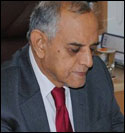 Dr. C.S. Viswanatha, Chairman of Civil-Aid Technologies Pvt. Ltd, sees unprecedented development in housing and infrastructure sectors. “Unlike the routine structures of the past, what are seen today are sophisticated, challenging and gigantic structures, he says.
Dr. C.S. Viswanatha, Chairman of Civil-Aid Technologies Pvt. Ltd, sees unprecedented development in housing and infrastructure sectors. “Unlike the routine structures of the past, what are seen today are sophisticated, challenging and gigantic structures, he says.
Elaborating, Dr. Viswanatha told Projectmonitor that developments in the field of engineering structures, particularly in the domain of concrete and steel structures, was phenomenal in the last decade. “In the first four decades of my professional career I did not see much brightness in these fields, but in the last decade it has been exemplary, in the Indian context. Several new construction materials, utilisation of industrial waste to get better construction products and greener materials for sustainability have become the hallmarks,” he said.
Dr. Viswanatha is a tremendous achiever both in his career and academic life. He graduated in civil engineering with distinction from Mysore University in 1960 and obtained Master’s and Doctorate in structural engineering from Indian Institute of Science, Bangalore, in 1962 and 1981 respectively. He served as a Member of Faculty at IIS-B during 1963-1980 and subsequently joined Torsteel Research Foundation in India. He is chairman of Civil-Aid Technologies Pvt. Ltd, which has since become a Bureau of Veritas Group company. His fields of specialisation include concrete technology, concrete and steel structures, hydraulic structures, precast constructions, and renovation, restoration and rehabilitation of structures.
On creation of awareness in the structural steel segment, Dr. Viswanatha says, “History has shown us that impressive and long-lasting structures have been generally structural steel. Although for quite sometime the interest in steel structures had waned out, there has been a renewal in interest towards that now.” In view of the swiftness in construction, imprinted quality in the components and aesthetic outlooks, steel structures are bound to bounce back, he stated.
According to Dr, Vishwanatha, there is a significant shift in the perception and potential about concrete. High strength-high performance concretes have become very popular while fly-ash and slag have become an integral part. Self-compacting concrete, self-curing concrete and geopolymer concrete are seen everywhere. Besides, manufactured aggregates have been highly promising. Coloured concrete, transparent concrete, self-healing concrete and many others have transformed the world of concrete. The outcome in terms of challenging constructions has been obvious.
Dr. Vishwanatha has published some 80 technical papers in national and international journals, edited Torsteel technical bulletins during 1981-93, and co-authored a Torsteel design handbook in 1988. He has been honoured with several awards like ACCE Gaurav Award 2000 by Association of Consulting Civil Engineers (India) for significant contribution to civil engineering consultancy; by India Chapter of American Concrete Institute, June 2003, for dedicated contributions in the field of reinforcements; ICI (KBC)-Birla Super Endowment Award for outstanding concrete technologist of Karnataka, for the year 2003, by the Indian Concrete Institute, Karnataka-Bangalore Centre; and Vishveshavariya Construction Excellence Award 2004, in March 2005, by Construction and Business Records, Navi Mumbai for outstanding engineer, among many other awards. He was also awarded Bharatha Ratna Sir M Visvesvaraya Memorial Award for the year 2006 by Builders’ Association of India, Karnataka.
He has served as president of Association of Consulting Civil Engineers (India) during 1988-1990 and Indian Concrete Institute during 1999-2001. At present, he is the chairman of Task Force on Quality Assurance in Public Constructions set up by Government of Karnataka and has been accorded Minister of State status.
Dr. Viswanatha sees plenty of opportunities for young engineers. “Instead of looking for opportunities elsewhere in the world, they can now look in our own terrain to execute world-class structures,” he advises. “In essence, I am convinced the future is quite bright.”











